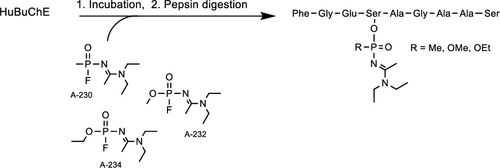当前位置:
X-MOL 学术
›
Chem. Res. Toxicol.
›
论文详情
Our official English website, www.x-mol.net, welcomes your
feedback! (Note: you will need to create a separate account there.)
Verification of Exposure to Novichok Nerve Agents Utilizing a Semitargeted Human Butyrylcholinesterase Nonapeptide Assay
Chemical Research in Toxicology ( IF 3.7 ) Pub Date : 2021-07-13 , DOI: 10.1021/acs.chemrestox.1c00198 Daan Noort 1 , Alex Fidder 1 , Debora van der Riet-van Oeveren 1 , Ruud Busker 1 , Marcel J van der Schans 1
Chemical Research in Toxicology ( IF 3.7 ) Pub Date : 2021-07-13 , DOI: 10.1021/acs.chemrestox.1c00198 Daan Noort 1 , Alex Fidder 1 , Debora van der Riet-van Oeveren 1 , Ruud Busker 1 , Marcel J van der Schans 1
Affiliation

|
Novichok (NV) nerve agents were recently added to the list of Schedule 1 chemicals of the Chemical Weapons Convention. There is a well-accepted method for assessment of nerve agent exposure based on mass spectrometric analysis of a nonapeptide with the serine-198 residue modified by the nerve agent, but this approach has not yet been reported for the class of NV agents and requires the availability of reference standards, which may be a limitation for NV agent exposure assessment. Thus, a goal of this study was to first verify the utility of the nonapeptide method for the characterization of human plasma samples exposed in vitro to the NV agents A-230, A-232, and A-234. A second aim was to evaluate the possibility of identifying unknown exposures by applying precursor ion scanning in combination with high resolution mass spectrometry (HRMS). Thus, precursor ion scanning, with a generic fragment ion (m/z 778) of the nonapeptide, was used to pinpoint any modified nonapeptide, while HRMS was used for structural elucidation of the adduct moiety. By this approach, use of HRMS enabled differentiation between adducts of agents with similar molecular masses. A new unique feature that could be exploited for NV nonapeptide analysis was that the modification was released from the peptide during fragmentation in the mass spectrometer and was detected in the low-mass region of the mass spectrum. This low-mass region was extremely informative and contributed to the assignment of the structure of the particular agent used, which is especially important in case no reference materials are available. The presented method is important for verification purposes by the Organisation for Prohibition of Chemical Weapons (OPCW), e.g., in case of investigations of alleged use of NV agents, and for regular forensic investigations.
中文翻译:

使用半靶向人丁酰胆碱酯酶九肽检测验证 Novichok 神经毒剂的暴露情况
Novichok (NV) 神经毒剂最近被添加到《化学武器公约》附表 1 化学品清单中。有一种广为接受的神经毒剂暴露评估方法,其基于神经毒剂修饰的丝氨酸 198 残基的九肽的质谱分析,但该方法尚未报告用于 NV 毒剂类别,并且需要参考标准的可用性,这可能是 NV 试剂暴露评估的一个限制。因此,本研究的一个目标是首先验证九肽方法对体外暴露的人血浆样品进行表征的效用。NV 代理 A-230、A-232 和 A-234。第二个目的是通过应用前体离子扫描结合高分辨率质谱 (HRMS) 来评估识别未知暴露的可能性。因此,前体离子扫描,具有通用碎片离子(m / z778) 的九肽,用于查明任何修饰的九肽,而 HRMS 用于加合物部分的结构解析。通过这种方法,HRMS 的使用能够区分具有相似分子量的试剂的加合物。可用于 NV 九肽分析的一个新的独特特征是,修饰在质谱仪的碎裂过程中从肽中释放出来,并在质谱的低质量区域中检测到。这个低质量区域非常有用,有助于确定所用特定试剂的结构,这在没有参考材料的情况下尤为重要。所提出的方法对于禁止化学武器组织 (OPCW) 的验证目的很重要,例如,
更新日期:2021-08-16
中文翻译:

使用半靶向人丁酰胆碱酯酶九肽检测验证 Novichok 神经毒剂的暴露情况
Novichok (NV) 神经毒剂最近被添加到《化学武器公约》附表 1 化学品清单中。有一种广为接受的神经毒剂暴露评估方法,其基于神经毒剂修饰的丝氨酸 198 残基的九肽的质谱分析,但该方法尚未报告用于 NV 毒剂类别,并且需要参考标准的可用性,这可能是 NV 试剂暴露评估的一个限制。因此,本研究的一个目标是首先验证九肽方法对体外暴露的人血浆样品进行表征的效用。NV 代理 A-230、A-232 和 A-234。第二个目的是通过应用前体离子扫描结合高分辨率质谱 (HRMS) 来评估识别未知暴露的可能性。因此,前体离子扫描,具有通用碎片离子(m / z778) 的九肽,用于查明任何修饰的九肽,而 HRMS 用于加合物部分的结构解析。通过这种方法,HRMS 的使用能够区分具有相似分子量的试剂的加合物。可用于 NV 九肽分析的一个新的独特特征是,修饰在质谱仪的碎裂过程中从肽中释放出来,并在质谱的低质量区域中检测到。这个低质量区域非常有用,有助于确定所用特定试剂的结构,这在没有参考材料的情况下尤为重要。所提出的方法对于禁止化学武器组织 (OPCW) 的验证目的很重要,例如,










































 京公网安备 11010802027423号
京公网安备 11010802027423号